Harlequin ducks are a small, seagoing species that live along the coasts of North America and eastern Russia. They are colorful birds with contrasting patterns on their heads, necks, wings, and chests.
As is the case with most waterfowl, females are not brightly colored. This helps them avoid notice while nesting, aiding their chances of survival. Read on to learn about the harlequin duck.
Description of the Harlequin Duck
It is honestly difficult to describe the male harlequin because he has such interesting plumage, or feathers. A small area at the top of his head, and a large area under his wing, is burnt-reddish in color. His body is slate gray, his head is black, and he has patches of bright white feathers on his head, neck, wings, back, and breast.
Females are dull gray, with patches of white only on their face. Both males and females are similar in size, about two feet long and a little over a pound.
Interesting Facts About the Harlequin Duck
These ducks have beautiful feathers with interesting patterns. Learn what else makes them unique and outstanding below.
- Homecoming – Like many other species of waterfowl, groups of migrating harlequins tend to return to the same location over and over. Because of this, sometimes huge numbers congregate in a single area. In fact, the vast majority of the population in North America spends the winter off the coast of Maine.
- Brood Patch – Female harlequin ducks are dedicated mothers, often before their ducklings even hatch! While building her nest, the female pulls out a large patch of feathers on her underside. She adds these feathers to the nest to help cushion and incubate the eggs. The ensuing bald patch on her skin actually helps warm the eggs even more efficiently during incubation.
- Sea Mouse – This species of duck has an interesting nickname among locals, they often call it the “sea mouse.” Instead of the traditional “quack” that we often associated with ducks, this species makes more of a squeaking sound!
- Deadbeat Dads – Ok, deadbeat is a little harsh, but male harlequin ducks do not participate in the raising of their young. While the female is incubating her clutch of eggs, the male returns to the sea to molt his feathers. Males do, however, assist in the protection of their mates while building the nest and laying the eggs.
Habitat of the Harlequin Duck
This species’ habitat choice depends on the season at hand. While they are breeding, these ducks live alongside rivers or streams.
They prefer fast moving water and rocky regions, especially those with dense forests and lots of shrubs on the ground. During the winter, these ducks migrate to the sea and live along rocky coasts and shallow waters.
Distribution of the Harlequin Duck
During the winter, these ducks live along the coast in the ocean. During the summer they range farther inland, but not by much. Because of this, they inhabit coastlines and some inland regions along eastern Russia and both coasts in North America.
Their range in North America extends from the Northern United States to Alaska on the west coast. On the east coast, the breed in Northern Quebec and eastern Nunavut, and spend the winter in the northeast United States.
Diet of the Harlequin Duck
This species of duck is primarily carnivorous, though their diet is mostly invertebrates. They feed on insects, larvae, shrimp, small crabs, mussels, clams, snails, and small fish.
While foraging, they dive to capture prey, particularly in deeper waters. When they are in shallow waters they also dabble beneath the surface. They flip upside down with their feet in the air and use their long necks to forage for prey.
Harlequin Duck and Human Interaction
These ducks have a steady overall population, but regional populations vary in stability. They are particularly susceptible to climate change, pollution, and habitat destruction.
Their habit of overwintering in large groups also puts high percentages of the population in danger if oil spills occur. For now, the IUCN lists this species as Least Concern.
Domestication
Humans have not domesticated harlequin ducks in any way.
Does the Harlequin Duck Make a Good Pet
No, these ducks do not make good pets. Though they are beautiful, they are wild animals and do not behave like their domesticated counterparts. In many places, it is illegal to own a harlequin as a pet.
Harlequin Duck Care
In a zoological setting, this species of duck requires a more carnivorous diet than most. They thrive on small fish, crustaceans, insects, and pelleted diets high in protein.
Their habitats must have plenty of water for them to swim and dive in. They fare best in colder climates, which replicate the temperatures of their natural range in the northern hemisphere.
Behavior of the Harlequin Duck
These ducks spend much of their time foraging for food. They feed in both shallow waters and areas where they must dive to capture prey. Unlike most waterfowl, they can swim in fast moving and rough waters.
They migrate seasonally, and each regional population undergoes its own migration route. Males and females migrate at different times of year because females must remain longer to raise their young.
Reproduction of the Harlequin Duck
Females choose the males with the brightest colors and cleanest feathers. Clean, bright plumage is a good sign of a healthy bird in any species. They breed with a single partner, but often choose a new one the following year.
The female lays between five and eight eggs, and incubates them for about a month. The ducklings follow their mother soon after hatching, and she leads them to food. By the time they are two months old most ducklings learn how to fly. The ducklings stay with their mother until it is time to migrate.

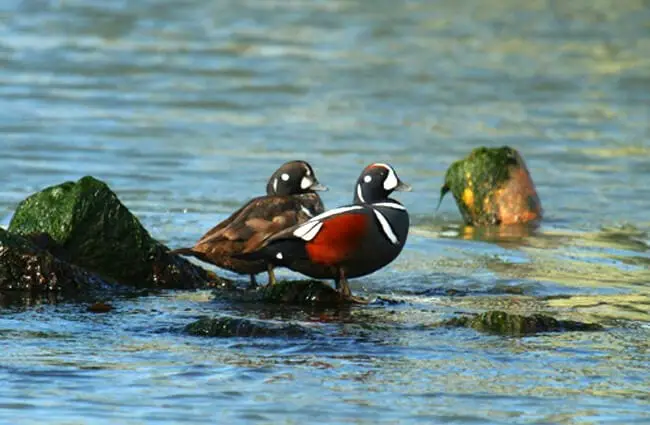


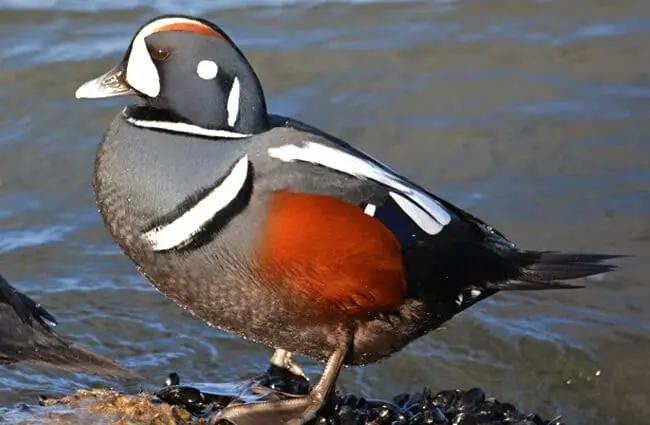

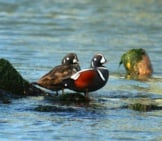
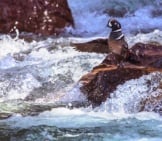
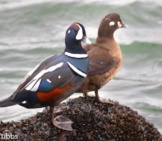

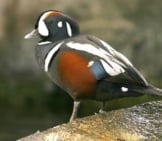
![Red Angus Closeup of a beautiful Red Angus cowPhoto by: U.S. Department of Agriculture [pubic domain]https://creativecommons.org/licenses/by/2.0/](https://animals.net/wp-content/uploads/2020/03/Red-Angus-4-238x178.jpg)












![Red Angus Closeup of a beautiful Red Angus cowPhoto by: U.S. Department of Agriculture [pubic domain]https://creativecommons.org/licenses/by/2.0/](https://animals.net/wp-content/uploads/2020/03/Red-Angus-4-100x75.jpg)

